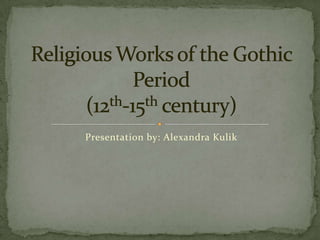
Religious works of the Gothic Period
- 1. Presentation by: Alexandra Kulik
- 2. Originated in Paris Lasted 400 years Emerged initially through impressive architectural techniques—(pointed arch, ribbed vault, flying buttress) Abbot Suger and St. Denis cathedral Usually described in terms of 4 phases: Early Gothic, High Gothic, Rayonnant, and Flamboyant. Devotio Moderna
- 3. New institution emerged in the opening years of the 13th century: the University. Christian Humanism Rapidly increasing population throughout Europe Anselm of Canterbury and Thomas Aquinas redevelop Aristotle’s theories. Reign of Louis IX Increasing demand for scholarship Materialism into spirituality Production of books The Black Death Mendicants
- 4. • Geometric golden lines of light “My mouth shall speak • Aristotle and truth and Plato on each side wickedness is an • Laymen and clerics, abomination bathed in the rays of learning to my lips.”
- 5. Primary medias for painting: panel, stained glass, fresco, illuminated manuscripts. Was often typological- illustrating the stories of the new and old testament side by side. Depictions often included the lives of saints—but the images of the virgin and the crucifix proliferated more than any other. Interested in describing the appearance of the natural and spiritual world. Glowing manifestations of Christian doctrine, encouraging worshippers to follow in the footsteps of saints. “The Heavenly Jerusalem” –glorious jeweled houses of God. Crystalline appearance, new visions of space, celestial light. Most figures were set within an architectural enclosure.
- 6.
- 7. From the St. Louis Psalter Illumination on parchment B initial begins the first psalm In the top half, King David stares down upon the bathing Bathsheba. In the lower half, King David kneels in repentance before God. Enthroned by a fiery mandorla or almond-shaped halo. Indicates that God is an object of higher vision. Abstract shapes and wavy lines were the means of distinguishing different levels of reality within a picture.
- 8. From the Revelations of St. Bridget of Sweden Illumination on parchment Inspired by St. Bridget’s vision of the Eucharist Direct line of sight to God, joining into one single stream before entering the eyes (vision) of the seated saint. Images like this allowed ordinary Christians access to things beyond their own powers of sight. Intromission
- 9. Time had a purpose and plan, organized by God who existed outside of time Visual forms were often seen in an eschatological framework—past, present, and future were often combined The future meant the end: The Last Judgment Visions of God were stimulated most profoundly by his absence People felt a more direct relationship with God The fragmentation of Christ’s life (and the Passion) Mystical Visions • Plant life represented new importance given to perception and sensation • Was not seen as “decorative” or as simple observations, devoid of meaning. • Nature was not just a thing, but a force. • A mixture of natural and supernatural elements
- 10. God the geometer, architect of all things. Construction of the cosmos with His compass. Represents chaotic matter, from which He shaped the universe. Unlike earlier medieval scenes of creation, here God has to bend his back in the hard work of world-making.
- 11. Wood with traces of paint Virgin Mary cradling the dead body of Jesus The Lamentation of Christ Women’s spirituality focused on Christ as the object of his mother’s gaze Sense of heavy weight, maternal love, tactile pain
- 12. • Tempera on panel • Petalled roses set in the frame—signs of blood and death • Made for the purpose of empathy • Eliminates the sense of vision while engrossed in the sense of touch • Angels hold up Christ with delicate fingers • Christ is limp like a stuffed-toy and the instruments of the passion are reduced to the size of playthings. • Tears were meant to be shed before images such as this (as suggested by the black winged angel with swollen red eyes)
- 13. Man outstretched in a burial ground transformed into a symbolic Golgotha. Devil represented according to God bears a sword medieval and orb of dominion convention as a naked babe Man seized by archangel at the command of God
